Humane Strategies for Bat Removal from Eaves
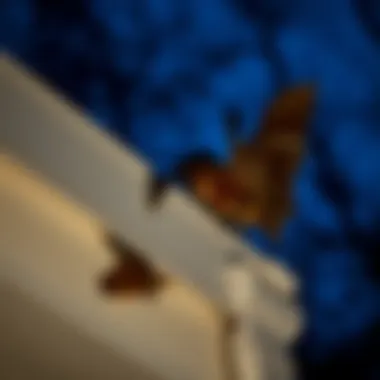

Intro
Removing bats from eaves can be a tricky task, often requiring a finely-tuned approach. Bats, being a vital part of many ecosystems, play essential roles in pest control, pollination, and seed dispersal. Thus, their removal should be conducted with both caution and consideration for ecological balance. In this section, we will address the significance of understanding bat behavior prior to undertaking removal, the techniques for humane methods, and post-removal care that ensures a healthy ecosystem continues thriving.
Forest Ecology and Biodiversity
Importance of Forest Ecosystems
Forest ecosystems function as homes for diverse species and serve critical roles in maintaining air and water quality, regulating climate, and providing resources for communities. The roots of deep-seated trees anchor the soil, preventing erosion, while leaves purify the air we breathe. It’s essential to maintain bat populations within these ecosystems, as they consume vast quantities of insects, reducing the need for chemical pesticides.
Flora and Fauna in Woodlands
In woodlands, one can find a mix of flora and fauna that interrelate in a delicate balance. For instance, bats often roost among various tree species, finding shelter and food while aiding in the dispersion of seeds for plants. This interdependence highlights the intricate web of life in these ecosystems.
- Native Trees: Species like oak, maple, and birch not only provide homes for bats but also support numerous other wildlife.
- Insects: Bats feast on many types of insects, like moths and beetles, playing a role in controlling their populations.
Sustainable Forestry Practices
Techniques for Responsible Management
Sustainable forestry is crucial in ensuring that forests remain productive and healthy. Practices such as selective logging, respecting wildlife habitats, and replanting efforts help maintain the balance. Ensuring that at least three trees are planted for every one removed can significantly enhance forest resilience. Techniques that promotes wildlife corridors aid in maintaining bat populations as they navigate through their habitats.
Certification Schemes and Standards
Organizations such as the Forest Stewardship Council (FSC) certify some forestry practices that emphasize environmental responsibility. These schemes often require extensive assessments and tracking of biodiversity impacts, ensuring that harmful practices are minimized. It’s crucial for forestry professionals to align their practices with such standards to promote health and biodiversity in ecosystems.
Community Engagement and Stewardship
Role of Local Communities
Local communities play a pivotal role in bat stewardship. Educating the public about the benefits of bats not only helps to reduce fear but encourages protection efforts. Participation in local advisory councils that focus on woodland management can allow community members to voice their concerns and learn about sustainable practices.
Volunteer Opportunities for Engagement
Engagement through volunteer initiatives harnesses community spirit while fostering awareness about wildlife conservation. Activities such as bat monitoring projects, tree planting events, or habitat restoration can have significant impacts.
“Preserving our planet's biodiversity is a shared responsibility. Together we can maintain a healthy ecosystem.”
Understanding Bats and Their Habitats
Understanding bats and their habitats is foundational for anyone looking to address the challenges of bat removal from eaves. These creatures play crucial roles in our ecosystems, and an awareness of their behaviors and needs is critical not only for effective removal but also for ensuring we respect their ecological contributions.
Bats are often characterized as the misunderstood mammals of our environment. While they may stir up a flurry of anxiety when roosting in eaves, their benefits to our surroundings are substantial. These creatures are nature's pest control agents, voraciously consuming unwanted insects. By keeping pest populations in check, bats contribute to agricultural productivity and support healthy ecosystems.
In addition, bats are also excellent pollinators and seed dispersers, promoting biodiversity. Tapping into this understanding emphasizes the importance of considering humane strategies for removal. Instead of viewing bats merely as nuisances, it's pivotal to recognize them as invaluable members of our ecosystems.
Here are several key elements to consider regarding bats and their habitats:
- Habitats: Bats typically prefer dark, enclosed, and undisturbed spaces that provide protection from predators. Eaves are appealing due to their accessibility and shielding characteristics, often making them prime real estate for bat roosting.
- Behaviors: Understanding bat behaviors, such as their nocturnal activity and social structures, can aid in times of removal. Knowing when they are most likely to be active enables more strategic removal tactics.
- Seasonal Migration: Many bat species migrate during different seasons. Understanding these patterns can help whether it’s discerning when to remove bats safely or when to implement long-term preventive measures.
With this framework in mind, the subsequent exploration into the ecological importance of bats, the common types found in eaves, and the characteristics of eaves supporting bat habitation becomes clearer. This knowledge intertwines with effective removal strategies, ensuring that we foster a more harmonious coexistence with nature.
"Bats are the unsung heroes of the night, performing vital ecological services that benefit all of us. Understanding their roles can make a world of difference in how we manage their presence in human-inhabited spaces."
By approaching bat removal from this informed perspective, we guide ourselves toward humane and efficient strategies.
Ecological Importance of Bats
Bats are not just another critter hanging upside down; they’re essential for the health of many ecosystems. As primarily insectivores, certain bat species consume massive quantities of insects, with some estimates ranging up to a thousand mosquitoes in a single evening. This natural pest control reduces the need for chemical pesticides, benefiting agricultural practices and enhancing local biodiversity.
Moreover, bat populations contribute to the pollination of various plants, including fruits like bananas and avocados. Without these nocturnal pollinators, many crops would struggle, directly affecting food chains and local economies. Their role in seed dispersal also means the perpetuation of forests and diverse plant species, making them integral to healthy landscapes.
Common Types of Bats Found in Eaves
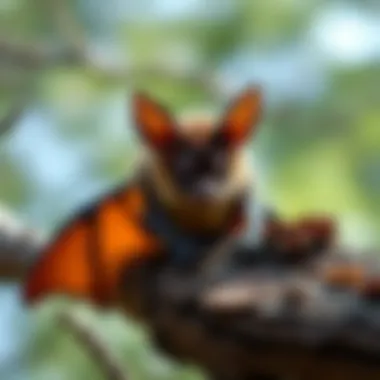
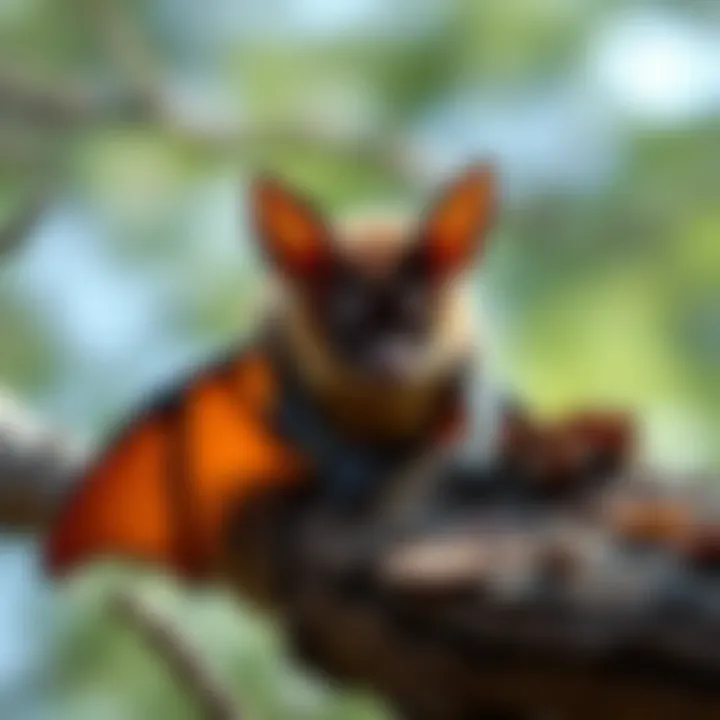
Within urban and suburban contexts, the types of bats frequently roosting in eaves include:
- Little Brown Bat (Myotis lucifugus): Known for their small size and adaptability, they can often be found in buildings, including eaves.
- Big Brown Bat (Eptesicus fuscus): Larger than their little counterparts, they favor attics and are common in many regions across North America.
- Western Pipistrelle (Pipistrellus hesperus): A small bat known for its agility and quick movements, often sought for roosting in secluded areas.
Considering these species and their preferences helps tailor removal strategies effectively and provides insight into their behaviors and needs.
Typical Eave Characteristics Favoring Bat Colonization
Eaves can become ideal roosting sites for bats due to several defining characteristics:
- Dark Spaces: Bats seek out dark, protected areas that offer seclusion—perfect for sheltering them from predators and harsh weather.
- Gaps and Cracks: Bats are adept at finding even the smallest gaps to enter. Eaves that have loose shingles, cracks, or gaps between structural elements are particularly prone to colonization.
- Low Human Activity: Areas with minimal human disturbance are attractive to bats, as they are naturally wary of potential threats.
Awareness of these traits not only informs effective bat removal strategies but also assists in preventative measures, keeping these beneficial creatures out without unnecessary harm.
Identifying Bat Presence in Eaves
Understanding how to identify bat presence in eaves is a crucial step in managing these creatures effectively. For those living near wooded areas or in rural settings, recognizing signs of bat activity is not just about protecting home and property. Bats play an essential role in our ecosystems, contributing significantly to pest control and pollination. However, when they decide to roost in eaves, they can present challenges as they bring about hygiene concerns and potential property damage. Hence, early identification can prevent bigger headaches down the line.
Signs of Bat Infestation
Bat infestations can often be spotted before they become a noticeable problem. Here are some key indicators:
- Droppings: Bat droppings, also known as guano, tend to accumulate under roosting spots. They are small, dark, and can resemble mouse droppings, although they are often more crumbly.
- Noises: Listen for subtle sounds coming from the eaves, particularly at dusk or dawn. Bats might make squeaking or chirping noises, especially if disturbed.
- Odor: A strong, musty smell can also indicate bat presence, particularly if droppings have accumulated. This distinctive scent often proves an early warning sign.
- Oil Marks: Over time, oils from bat fur can leave dark streaks on surfaces below their roost. Look for these marks, especially around entry points or along the siding where they prefer to roost.
- Presence of Young: During the spring and summer months, baby bats might be present. Their high-pitched squeaks can be a giveaway during these times.
Knowing these signs can help you address any potential issues early on, keeping your home safe and clean.
Behavioral Patterns of Bats
Bats exhibit fascinating behaviors that can aid in identifying them. Unlike other wildlife, their nocturnal habits can be somewhat of a challenge for observation. However, understanding their patterns can inform homeowners about their roosting behaviors.
- Evasion Tactics: Bats are incredibly agile, and they often evade threats by quickly darting away. This skill is prominent at dusk when they emerge for foraging. If you spot a flurry of activity just after sunset, there's a good chance there's a nearby colony.
- Communal Roosting: Many species of bats prefer to roost in groups. If you've identified signs of one bat, it’s likely that others are nearby. Paying attention to gatherings can assist in identifying larger infestations.
- Slight Social Structure: Bats often have a social structure that influences their behavior. For instance, females typically gather in maternity colonies, which can be particularly noticeable in warmer months. Observing this can inform your removal strategies since timings may differ based on the seasons.
Insights into behavioral patterns are invaluable for strategic management.
Best Times to Observe Bats
Knowing when to look for bats can facilitate early detection should you sense their presence in your eaves. Understanding their daily rhythms can yield numerous advantages:
- Dusk and Dawn: As creatures of the night, bats are most active during twilight hours. Dusk and dawn are prime times to watch for flights as they venture out or return to roost.
- Seasonal Variation: Spring and summer are peak activity seasons, particularly when young bats take flight for the first time. Observing during these months may provide more clues than other times of the year.
- After Rain: Bats tend to become more active after rain, taking advantage of the surge in insects. If the weather is wet, keep an eye out for their movements shortly after.
Awareness of these factors can significantly enhance your ability to identify and address bat presence. With the right knowledge, you can approach removal respectfully and effectively, ensuring both your home and the local ecosystem remain healthy.
Legal Considerations and Ethics
Understanding the legal landscape surrounding bat removal is not just a formality. It’s a necessity that holds significant ramifications for both the bats and the individuals involved in their removal. In many regions, bats are protected under local, state, or federal laws due to their crucial role in the ecosystem. Ignoring these regulations can lead to hefty fines and even legal charges. This section explores the legalities and ethical considerations that should guide anyone engaging in bat removal from eaves, highlighting the benefits of respecting these parameters.
Local Laws Regarding Bat Removal
Whether you live in a bustling urban area or a serene rural setting, it’s vital to familiarize yourself with the local laws that govern bat conservation and removal. Many states enforce specific regulations that safeguard bats from harm throughout particular seasons, particularly during their maternity period. Not adhering to these rules can lead to serious penalties. For example, some areas consider it illegal to disturb bats while they are roosting or to capture them without a proper license.
- Licensing Requirements: Often, a professional may need a permit to handle bats legally. Check with your local wildlife authority or environmental agency regarding necessary permits.
- Seasonal Restrictions: It's crucial to identify protected times for bat activity. This could include periods from spring through summer when bats are raising their young.
- Local Wildlife Protection: Some regions have stricter regulations that could require the presence of certified professionals to carry out bat removal tasks, ensuring compliance with all relevant laws.
Consulting with a local wildlife expert or the state’s fish and game department can provide essential guidance and clarity on these regulations. Being well-informed not only protects wildlife but also shields homeowners from legal repercussions.
Ethical Approaches to Wildlife Removal
When one thinks of wildlife removal, swift action can seem like the name of the game, but ethics should drive every decision. Practicing humane bat removal isn’t just about compliance with laws; it’s about respecting and understanding these creatures' place in our ecosystem.
Approaching bat removal ethically focuses on several key principles:
- Humane Treatment: Any removal strategy should minimize suffering. Using traps that allow for safe, unharmed relocation should be a priority. Devices like one-way exits can be effective, allowing bats to leave without risk of injury or death.
- Conservation Mindset: Recognizing bats as valuable contributors to pest control and pollination can shift the paradigm from viewing them as nuisances to appreciating them as essential components of healthy ecosystems.
- Community Involvement: Engaging neighbors and local organizations in awareness efforts promotes understanding of bats’ ecological roles. Community initiatives can foster a more supportive environment for both humans and bats.
"Bats play a pivotal role in ecosystems by controlling insect populations, thus indirectly benefiting agricultural practices." (source: en.wikipedia.org)
Preparing for Bat Removal
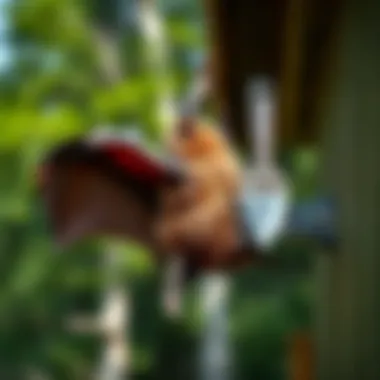
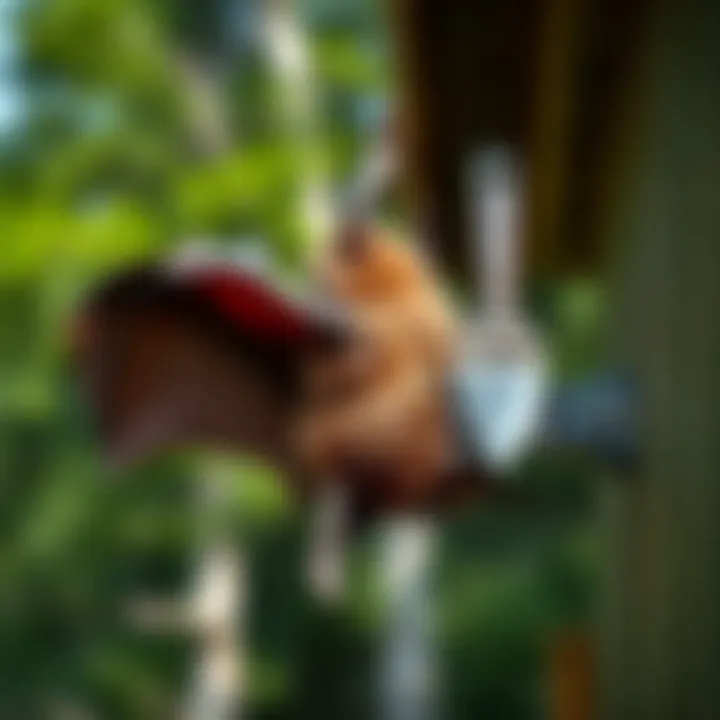
Preparing for bat removal is a critical phase in ensuring the process is both effective and humane. Taking the time to gather information and resources can make all the difference. Understanding this groundwork sets a solid foundation for the upcoming efforts.
First and foremost, it’s essential to recognize that bats are protected species in many regions. Before diving into removal, familiarize yourself with any local laws regarding bat management. This can save you a world of trouble down the line, both legally and ethically.
Beyond legalities, consider the health risks associated. Bat droppings, known as guano, can carry diseases that affect humans. Having the right preparation can minimize the risks to both the person performing the removal and any bystanders. This preparation phase does not just touch on gathering tools and checking regulations; it also delves into mental readiness. Be prepared for unexpected situations that might arise during the removal process. By planning ahead, you’re setting the stage for a smoother operation.
Essential Tools for Removal
When it comes to bat removal, having the right tools at your disposal is crucial. Here are some essentials you may need:
- Heavy-duty gloves: Protecting your hands is non-negotiable; bats can bite if they feel threatened.
- Face masks: Preventative gear against airborne pathogens is smart, especially when dealing with guano.
- One-way exclusion devices: These handy gadgets allow bats to exit but not re-enter, making them perfect for humane removal.
- Flashlight or headlamp: Good lighting helps in spotting bats, particularly in dim eaves or attics.
- Ladders or lifts: Depending on where the bats are roosting, ensure you have sturdy access equipment.
Getting these tools prepped and ready to roll minimizes any last-minute scrambles. In the world of wildlife removal, time often matters.
Safety Precautions to Consider
Safety should be at the forefront of any bat removal strategy. As mentioned earlier, the health risks associated with handling bats and their droppings cannot be understated. Some key precautions to consider include:
- Protective clothing: Beyond gloves and masks, consider a full-body suit for extra safety.
- First-aid kit: Be ready for any cuts or scrapes. A basic first-aid kit can come in handy after a long day's work.
- Working in pairs: It’s often wiser to have another person with you. Not just for assistance but also for safety.
- Preparing for bats' flight: When you start working in the eaves, bats may become startled and take flight. Having a plan for this scenario will keep you and others safe.
Keep safety protocols at the forefront. Ultimately, it’s about making the experience as secure as it is effective.
Timing Your Removal Efforts
Timing can make or break your bat removal efforts. Understanding when bats are most active is key in deciding your approach. Generally, bats are nocturnal, which means that late evenings or early mornings are prime times for sightings. In the throes of summer, it’s particularly vital to pick moments just after sunset or before sunrise for the most efficient results.
- Seasonal considerations: Spring and early summer are often when you’ll notice bats more as they look to establish roosts. Conversely, late summer and fall could see them looking for warmer spots as the temperatures dip.
- Avoiding maternity season: If it’s late spring to early summer, you may be dealing with nursing mothers and pups, making removal risky and illegal in some areas.
Incorporating these timing elements can lead to a much smoother process, reducing the chances of negative outcomes for both the bats and yourself. By carefully planning your operation, you’re more likely to have a successful bat removal experience.
Methods for Bat Exclusion
Bat exclusion measures are crucial for ensuring a harmonious balance between human habitation and wildlife conservation. It’s vital to understand that while bats play a critical role in pest control and pollination, their presence can sometimes lead to unwanted issues in urban or suburban environments. By implementing effective exclusion methods, property owners can not only remove these creatures humanely but also prevent them from returning.
The strategies employed for bat exclusion blend various techniques to ensure both effectiveness and adherence to ethical standards. Knowing how to properly exclude bats can save time and reduce frustrations down the line. Let’s delve into some tried and tested methods.
Using One-Way Exclusion Devices
One-way exclusion devices provide a clever solution to bat problems. These devices allow bats to exit the premises without letting them back in. Imagine it like a revolving door—only allowing a one-way street.
- Installation: One-way devices should be mounted at all known entry and exit points. The timing of their installation is crucial; placing them when bats are outside foraging is ideal. This way, they can safely leave but cannot re-enter once the sun sets.
- Benefits: The primary advantage of these devices is their humane nature. They do not harm the bats; instead, they encourage them to find a new dwelling while ensuring that they stay secure until they fly away.
- Considerations: Ensuring that all entry points are sealed after the bats have exited is essential to prevent future visitors. If even one small hole is left exposed, you might find that bats will return with a vengeance.
Preventive Barriers and Sealing Techniques
Prevention is often a better approach than cure. Once the bats have been removed, setting up barriers and sealing techniques is essential.
- Physical Barriers: Screens made from materials like wire mesh can effectively cover openings in eaves. Make sure the mesh is sturdy and installed tightly to prevent any gaps.
- Sealing Gaps: Employ high-quality caulk or expanding foam to seal off any cracks or holes where bats might try to squeeze through. Pay attention to areas around windows, vents, or where different building materials join.
By proactively fortifying your eaves, you create an environment that is less inviting to bats.
Natural Deterrents and Repellents
Sometimes, bats can be discouraged using methods that don’t involve physical removal. Integrating natural deterrents can often dissuade these creatures from making your eaves their home.
- Repellent Scents: Some scents naturally repel bats. For instance, substances like peppermint oil or vinegar can be utilized. Soaking cotton balls in these fragrances and placing them in problem areas might do the trick.
- Sound Devices: High-frequency sound devices designed to mimic predator calls are another potential deterrent. These sounds are often inaudible to humans but can dissuade bats from settling into your eaves.
By employing a combination of these strategies, property owners can greatly reduce the likelihood of bats choosing to nest in their eaves again. Each step taken not only protects personal living spaces but also supports the larger goal of responsible wildlife management.
Post-Removal Considerations
In the aftermath of a bat removal effort, several critical steps must be taken to ensure that the process maintains environmental integrity and reduces the chance of future infestations. Post-removal considerations are essential not only for the immediate safety of your property but also for the health of the local ecosystem. By addressing cleaning procedures, repairing damage, and creating an environment less appealing to bats, property owners can foster long-term success and coexistence with wildlife.
Establishing a clean and safe environment, coupled with preventative measures, ensures that bats and other wildlife do not view your eaves as an invitation to settle down again. Furthermore, these steps underscore a deeper understanding of ecological balance, which is particularly vital for professionals in forestry and wildlife management.
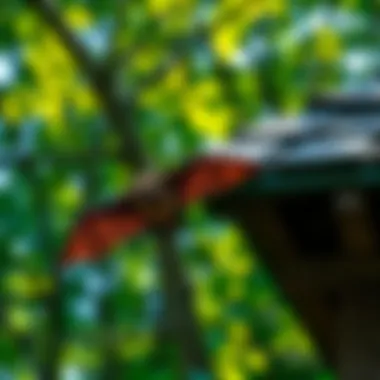
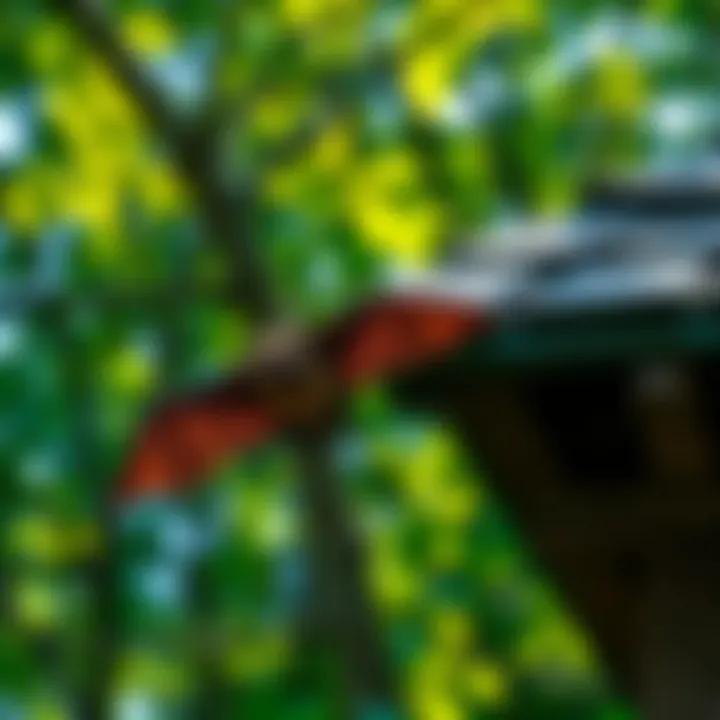
Cleaning and Sanitizing Areas
Once bats have vacated, the next step involves a thorough cleaning of the areas they inhabited. Bat droppings, known as guano, can host histoplasmosis, a serious respiratory disease. Thus, it’s imperative that you approach cleaning with care.
- Wear Appropriate Gear: Protect yourself with gloves, masks, and safety goggles to prevent inhaling spores.
- Remove Droppings and Debris: Carefully collect and dispose of guano using a shovel and a dustpan, placing it into heavy-duty trash bags. Avoid sweeping or vacuuming, as this can stir up particles into the air.
- Sanitize the Area: After debris removal, clean the surface with an enzyme cleaner or bleach solution to neutralize pathogens. Ensure proper ventilation during this process.
Paying attention to these details keeps you safe and paves the way for effective future management of your eaves and surroundings.
Repairing Damage from Bat Colonization
Bats can be resilient and resourceful creatures, often leaving behind significant evidence of their presence, which can affect the integrity of your eaves. Repairing this damage not only restores physical structure but also reinforces your property against future entries.
- Inspect the Area: Check for holes, chewed materials, or other signs of wear caused by bats.
- Seal Entry Points: Use materials like caulk, foam insulation, or screen wire to seal up any gaps. Doing this stops not only bats but also other pests from taking advantage of the weakened barriers.
- Reinforce Structures: Evaluate whether beams, insulation, or any wood has been compromised. Consider replacing them to prevent future nesting, ensuring that your property stands strong against future visitors.
Common sense dictates that a well-maintained eave will not only deter bats but also enhance the overall aesthetic of your home, ensuring harmony between human habitation and wildlife.
Creating an Unattractive Environment for Re-entry
Once bats have been successfully removed and the area cleaned and repaired, the final step is ensuring that your eaves do not re-attract bats. Creating a less hospitable atmosphere is essential in long-term bat management.
- Limiting Food Sources: Since bats feed on insects, reducing the overall insect population around your area can make your property less appealing. This may involve using sustainable pest control methods or planting bat-repellent plants.
- Adjusting Lighting: Bats are nocturnal; bright lights can be a deterrent. Consider using motion-sensor lights to create an uncomfortable environment for them.
- Landscaping Changes: Trim back trees or shrubs that provide cover for approaching bats. It’s also beneficial to maintain your yard by removing any debris that could serve as a potential shelter.
By truly understanding and addressing these elements, you can create a lasting effect that discourages any notion of bats re-entering your eaves. The meticulous methodologies described not only solve immediate concerns but also foster an ongoing relationship between humans and their environment, advocating for coexistence without adverse impacts.
Long-Term Prevention Strategies
When tackling bat removal from eaves, the journey doesn’t end when the last bat flies off into the twilight. It’s just the beginning of a more crucial phase: ensuring that bats don’t return. Long-term prevention strategies are essential to protect your property and to maintain a harmonious coexistence with wildlife. Implementing these strategies not only safeguards your structures but also promotes the ecological balance in your neighborhood.
Maintaining Eave Structures
A fundamental component in keeping bats at bay is the maintenance of eave structures. These areas are prime real estate for bats seeking shelter. It’se wise to regularly inspect and repair any gaps, cracks, or holes that might serve as entryways. Consider employing these tactics:
- Seal all gaps: Use materials like caulk or wire mesh to fill openings that are larger than a quarter inch. This simple step can work wonders in keeping bats outside.
- Install flashing: Add metal flashing at high-risk areas to deter entry. Bats prefer softer materials but certainly want to avoid hard surfaces.
- Regular inspections: Schedule routine inspections, especially before peak bat season, as maintenance often falls to the wayside with the hustle and bustle of everyday life.
By taking a proactive stance, homeowners not only protect their property, but also contribute to the well-being of local bat populations, should they exist nearby.
Environmental Management to Discourage Bat Habitation
Environmental factors can play a significant role in attracting or repelling bats. By managing the surrounding habitat, you can create an environment that's less appealing to these creatures. Key techniques include:
- Removing food sources: Bats usually follow their food. Mojo beetles, moths, and flying insects prevail in poorly maintained gardens. Implementing pest control measures not only reduces the insect population but also discourages bats from taking up residence nearby.
- Landscaping changes: Trim overhanging branches and clear dense vegetation that bats might use as landing pads.
- Water features: If there are fountains or ponds nearby, cover or treat them to control insect populations.
These strategies can help make your property less attractive, ensuring that bats seek shelter elsewhere.
Community Awareness and Education
It’s crucial to remember that bat prevention isn’t solely a personal endeavor; rather, it’s a community challenge. Raising awareness among neighbors can be effective in ensuring long-term success. Ways to engage with your community include:
- Workshops: Organize or attend local workshops to educate homeowners about bat behaviors and how to address bat-related issues. This serves as great community building.
- Information distribution: Distributing pamphlets or flyers can also help spread the word about maintaining bat-free eaves and the positive aspects of coexistence with wildlife.
- Social media engagement: Utilizing platforms like Facebook or Reddit to connect with community members can broaden the conversation about humane bat removal and prevention.
Educational initiatives not only bolster community efforts but also promote a deeper understanding of the ecological value of bats.
“Awareness doesn’t just build knowledge; it fosters responsibility towards all creatures that share our environment.”
Long-term prevention strategies digest the complexities of bat control into manageable tasks that homeowners and communities can prioritize. By maintaining structures, managing environments, and fostering community spirit, we pave the path toward a bat-free, yet ecologically harmonious existence.
Epilogue
The conclusion of this article serves as a crucial platform that ties together the myriad of strategies discussed for effective bat removal from eaves. Understanding the methodologies and practices surrounding bat exclusion not only emphasizes humane treatment but also highlights the importance of ecological balance. Through effective bat removal practices, homeowners not only create a safer living environment but also contribute to the preservation of these vital creatures that play a significant role in our ecosystems.
Summarizing Effective Bat Removal Practices
To summarize, removing bats from eaves involves a careful and methodical approach. Here are the key elements:
- Inspection and Monitoring: It all starts with identifying signs of bat presence, which might include droppings, noises, or even visual cues of their entry points. Knowing when and where to look significantly enhances the likelihood of successful identification.
- Legal and Ethical Considerations: Awareness of local laws regarding bat removal is paramount. In many regions, bats are protected species, making it illegal to harm them. Adopting ethical approaches can aid in ensuring compliance with these regulations.
- Utilizing One-Way Exclusion Devices: This method allows bats to exit without the chance of re-entry. Such devices are an excellent way to manage the transition effectively and humanely without causing distress to the animals.
- Preventive Measures: After removal, sealing the eaves properly and creating barriers discourage future inhabiting by bats while safeguarding your structure as well.
"Prior knowledge leads to efficient planning, which is crucial when handling wildlife, including bats."
Final Thoughts on Coexisting with Wildlife
Coexisting with wildlife, particularly bats, is not just a matter of concern for the individual; it transcends personal space management to touch upon broader environmental impacts. By understanding bats and their ecological roles, communities can develop a more harmonious relationship with these nocturnal mammals.
- Education and Community Engagement: Raising awareness about the benefits of bats can change perceptions and encourage positive attitudes toward wildlife. Workshops and information sessions can inform the public about bats' role in pest control, which can help reduce misunderstandings.
- Sustainable Practices: Implementing sustainable practices in community planning helps avoid conflict with wildlife habitats. Green roofs and native vegetation can provide natural deterrents while fostering harmony between human needs and wildlife conservation.
- Long-term Commitment: Strategies for prevention must be ongoing. Continuous monitoring, community engagement, and adherence to ecological practices will ensure that interactions with bats remain positive and beneficial for both parties.















